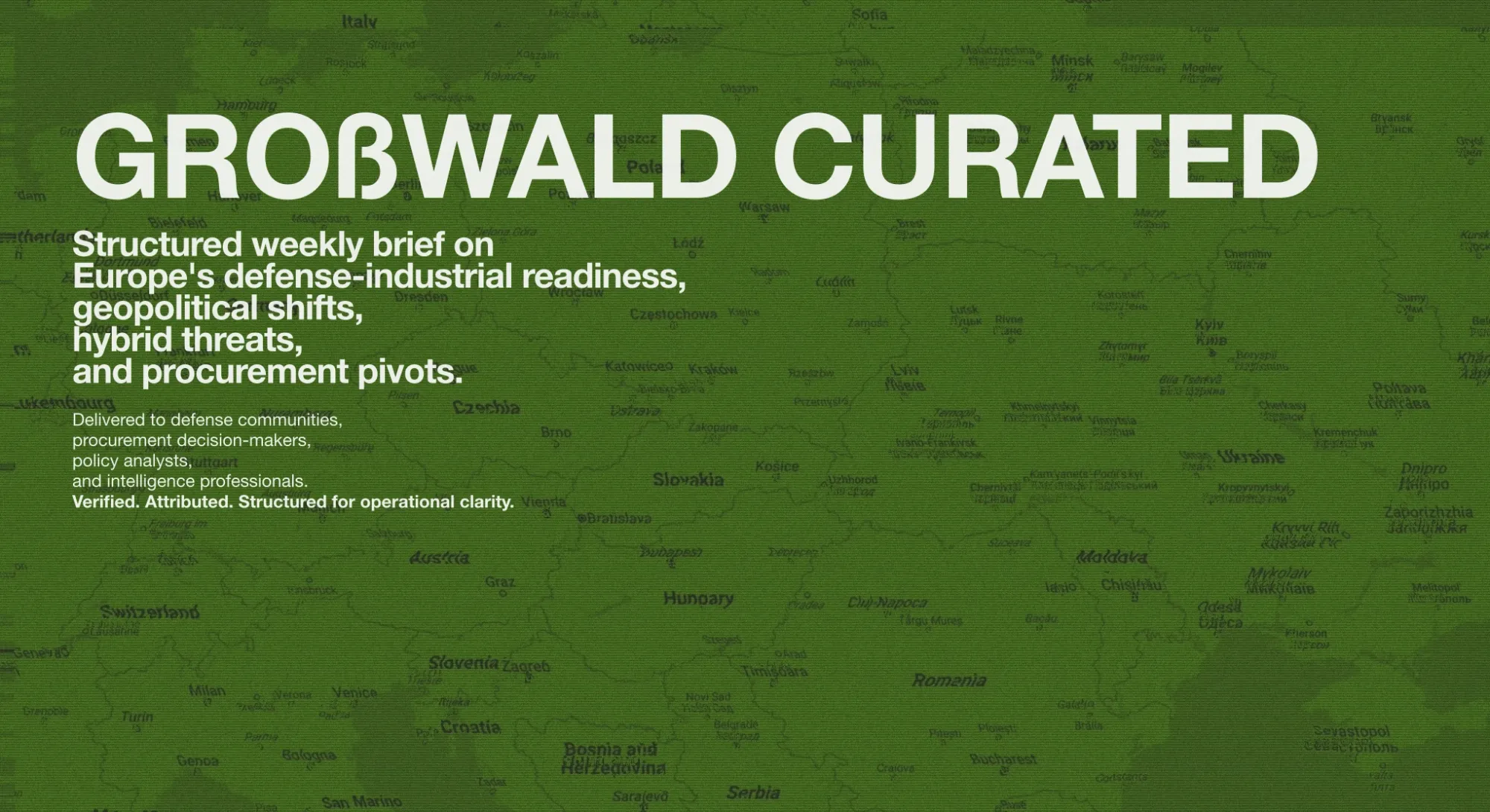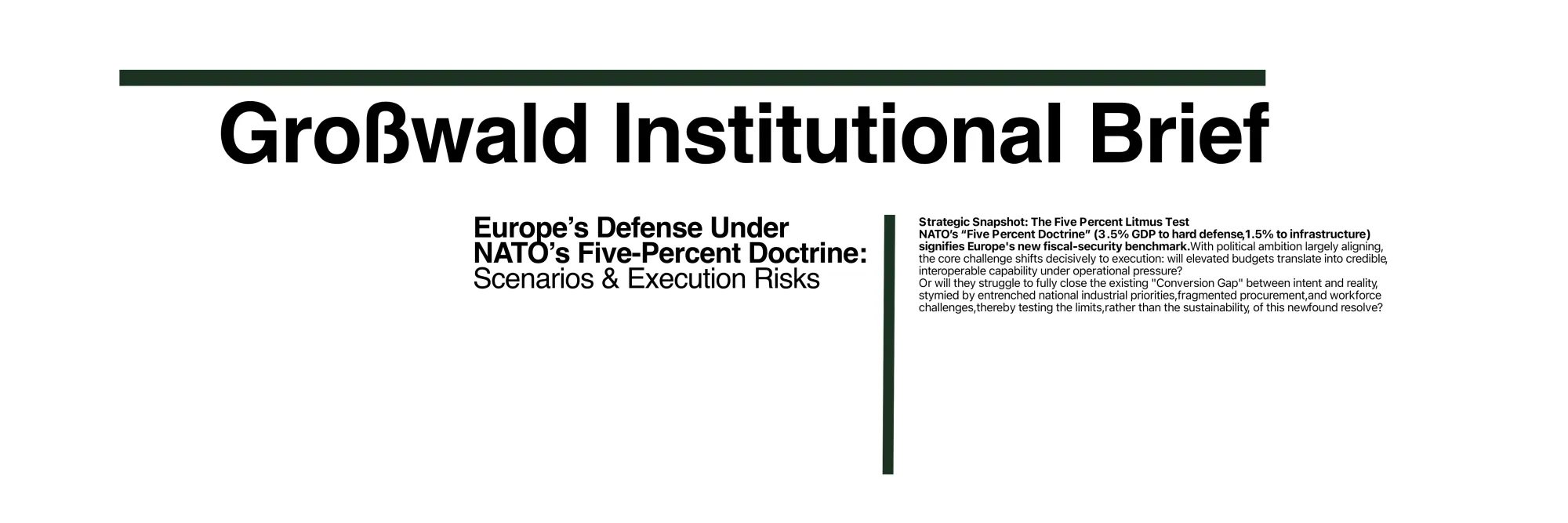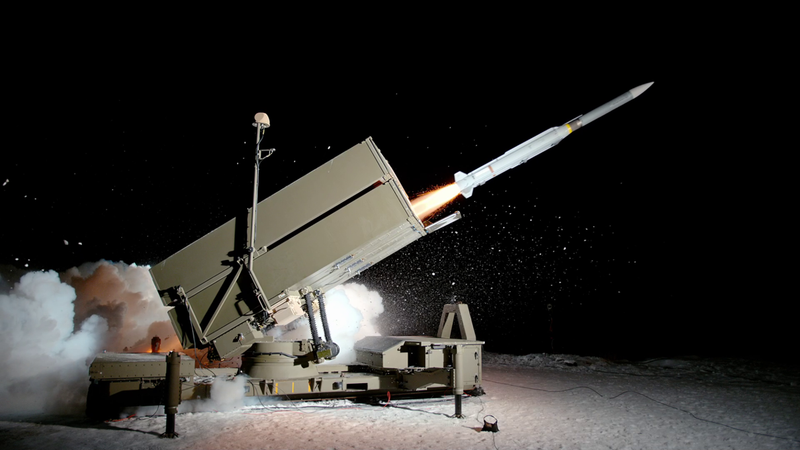Europe’s Defense Under NATO’s Five‑Percent Doctrine: Scenarios & Execution Risks
For Executive Decision Makers:
Großwald Institutional Brief – Strategic Scenarios, Risks & Capability Paths
Großwald Policy Desk - grosswald.org
1. C‑Level Executive Summary
NATO’s Five‑Percent Doctrine (3.5% GDP defense, 1.5% infrastructure) is a fiscal-security threshold. Political alignment is historic. Execution is critical: budgets must yield joint-ready forces. Otherwise, the known “conversion gap” persists due to procurement fragmentation and workforce shortages.
Großwald Assessment: The most likely path is gradual progress (Scenario B), with meaningful upside (A) possible if reforms latch. Systemic failure (C) is unlikely but still a risk.
2. Posture & Consequence
Scenario A (Medium probability): Full spend conversion, stronger NATO deterrence, market stability.
Scenario B (High probability): Partial conversion, persistent gaps, portfolio volatility.
Scenario C (Low probability): Stagnation, deterrence failure, high sovereign risk.
3. Core Thesis
Europe must move beyond budget targets into execution—requiring procurement agility, industrial integration, manpower scaling, resilient supply chains, and adaptive doctrine.
4. Context
High‑intensity eastern conflict and hybrid threats (Odessa strike, BALTOPS drones, shadow fleets) underscore urgency and expose readiness gaps driven by procurement delays.
5. Scenario Modeling (12‑18 months)
| Scenario | Fiscal Spend | Force Generation | Strategic Output |
|---|---|---|---|
| A | Effective 5% spend | +40–60k troops | Robust deterrence |
| B | Target met but weak output | +20–30k troops | Limited gains |
| C | <3.5% spend | Manpower collapse | Credibility collapse |
6. Forward Indicators
- Manpower/reserve reform
- Output from key industrial programs
- IOC/FOC timing on drones, missiles
- After‑action reports from BALTOPS
- Shadow‑fleet interdiction stats
- Procurement reform adoption
7. Risk Synopsis
Execution-proof scenarios:
- A: Low risk, strong deterrence
- B: Moderate risk, fragile progress
- C: High risk, strategic failure
Final Take: Europe must leverage its strategic consensus now. The difference between muddling through and credible realignment depends on rapid, targeted execution in procurement, industrial scaling, and manpower—not budget alone.
Detailed Version Brief & Full Model
Großwald Institutional Brief
Strategic Briefing: Scenarios, Risks, and the Road to Credible European Defense. Execution Demands and Capability Paths.
Purpose: This brief models Europe’s defense posture over the next 12–18 months across three critical implementation scenarios.
Großwald Policy Desk - grosswald.org
Content
Executive Summary
Strategic Snapshot: The Five Percent Litmus Test
Posture & Consequence – Navigating Investment and Geopolitics
Scenario Risk/Reward Matrix
1. Context: Forging Doctrine for a New Security Reality
2. Scenario Modeling: Europe’s Defense Realignment (12-18 Months)
3. Forward Indicators: Monitoring the Implementation Trajectory
4. Risk Synopsis
Risk Matrix: Scenarios for Europe’s Five‑Percent Doctrine Execution
Assessment

Executive Summary
Strategic Snapshot: The Five Percent Litmus Test
NATO’s Five Percent Doctrine (3.5% GDP to defense, 1.5% to infra) sets a new fiscal-security line. Political will is forming. The real test: execution. Can spending yield real, joint-ready force under stress? Or will the “Conversion Gap” persist—blocked by national industry bias, fragmented buys, and talent shortfalls—pushing this resolve to its limits?
Großwald Assessment: Political alignment on 5% doctrine is historic. Most likely path: muddling through (B), with strong possibility of credible realignment (A) if targeted reforms succeed. Systemic failure (C) is least likely. Europe must convert fiscal momentum into execution gains now.
Posture & Consequence – Navigating Investment and Geopolitics
The trajectory of European defense investment carries direct strategic and financial implications, impacting everything from sector-specific valuations to broader market stability and sovereign risk:
- Scenario A (Credible Realignment): Represents successful conversion of fiscal commitment into enhanced, interoperable capability. Bolsters NATO deterrence, reinforces investor confidence in an attractive defense sector (potentially benefiting aerospace, defense, and select technology stocks), and reduces systemic geopolitical risk premiums on European assets. Strategic Upside & Enhanced Market Stability.
- Scenario B (Partial Attainment): Budgets rise, but persistent capability gaps, supply chain vulnerabilities, and execution inefficiencies signal strategic drift. This could lead to fraying alliance cohesion, volatile defense stock performance, and complicated long-term defense financing, potentially straining national budgets. Moderate Risk & Heightened Sector Volatility.
- Scenario C (Stagnation & Capability Lag): Indicates systemic failure to convert fiscal inputs into strategic outputs. This erodes deterrence, invites adversary opportunism, triggering a deteriorating investment climate, policy crises, and acute security risks. Expect heightened geopolitical market shocks, increased scrutiny on sovereign creditworthiness for lagging nations, and significant setbacks for critical infrastructure development and security. High Risk & Systemic Financial Vulnerability.
Scenario Risk/Reward Matrix:
|
|
|
|
|
|
|
|
|
|
|
|
|
|
|
|
Core Thesis: Beyond Budgets – Forging Genuine Capability from Renewed Commitments
The NATO-backed “Five Percent Doctrine”—allocating 3.5% of GDP to hard defense and 1.5% to critical infrastructure resilience—marks a potential strategic inflection point for European security.
With key states like Germany signaling alignment, the challenge rapidly evolves from fiscal declarations to demonstrating effective execution under persistent operational stress. This is not merely a budgetary exercise; it represents a test of Europe's collective ability to overcome long-standing structural impediments, including fragmented national industrial interests, complex procurement processes, and critical manpower shortfalls.
As defense commitments rise, so too will the demand for astute capital allocation, robust sovereign guarantees, and streamlined regulatory coordination—particularly across Eurozone markets characterized by uneven defense-industrial footprints and varying absorption capacities. The very definition of "capability" is expanding, requiring not just new hardware, but also integrated forces, resilient supply chains, a skilled workforce, and adaptable doctrines ready for a rapidly evolving threat landscape.
Nevertheless, the very establishment and broad acceptance of the Five-Percent Doctrine signifies a political Rubicon crossed. This creates a compelling, albeit challenging, imperative for member states to drive execution, making complete stagnation a less probable outcome than a period of determined, if uneven, implementation.
This brief maps three likely paths for Europe’s defense in the next 12–18 months—driven by eastern escalation, hybrid threats, and unstable transatlantic ties. It isolates the fiscal, industrial, and institutional levers that will decide if rising spend yields real force—or extends the known “conversion gap” between inputs and output, straining Europe’s fragile shift toward true strategic posture.
1. Context: Forging Doctrine for a New Security Reality
The Five-Percent Doctrine is a clear strategic need—driven by ongoing high-intensity war in the East and constant hybrid threats. Recent Russian strikes (Odessa), BALTOPS drone activity, shadow fleet runs, and critical infrastructure probes illustrate the evolving hybrid threat environment.
Key developments, frequently signaled in our weekly curated editions, directly shape this doctrine's execution environment:
- NATO Policy Hardening: Secretary-General Rutte’s "five-percent or fail" directive is gaining consensus, with Berlin and Paris now framing it as a "realistic" necessity ahead of The Hague summit.
- National Commitments vs. Systemic Strains: High-profile national commitments (e.g., Germany’s troop increase, Tomahawk deployment) are immediately confronted by well-documented structural impediments: fiscal efficacy warnings (Bundesrechnungshof), the persistent "missing million" manpower challenge, and acute supply-chain vulnerabilities (rare earths, F-126 frigate delays).
- The Asymmetric Warfare Imperative: Adapting to Rapid Innovation: The battlefield proves agile technologies now deliver strategic disruption: Ukraine’s SBU drone strikes gutting a significant portion of Russia’s strategic bomber fleet directly assault core capabilities. This, alongside emerging platform-agnostic threats like the MAGURA V7's AIM-9 naval drone kill (building on the V5's initial air-to-air success), mandates Europe rapidly adapt its defense calculus to this new era or risk ceding the advantage.
- Enduring Deficiencies: The "Readiness Delta" and "Conversion Gap"—disparities between spending and deployable power—remain critical concerns. These are exacerbated particularly by systemic procurement inefficiencies, alongside persistent industrial bottlenecks, regulatory impediments, and manpower shortfalls. While the U.S. now mandates acquisition speed via directives like EO 14267, European frameworks often default to procedural caution over operational tempo, directly impacting the ability to translate increased budgets into timely capability; a reality now under intense pressure for reform given the new strategic and fiscal commitments.
2. Scenario Modeling: Europe’s Defense Realignment (12-18 Months)
The evolution of Europe's defense capabilities will likely follow one of three primary paths, contingent on the effective mitigation of these identified challenges:
Realignment | |||||
Attainment | |||||
Capability Lag |
Assessment: Scenario A enhances Euro-Atlantic security and European strategic agency. Scenario B offers a precarious holding pattern, insufficient for sustained crisis. Scenario C actively degrades deterrence and invites instability.
3. Forward Indicators: Monitoring the Implementation Trajectory
The following indicators will provide critical insight into the prevailing trajectory:
Manpower Reform & Mobilization:
- Monitor: Legislative progress, public acceptance, and tangible recruitment/retention outcomes of conscription/reserve models in key states (Germany, Poland); resolution of systemic issues hindering reserve mobilization (e.g., Bundeswehr's 'missing million' data access).
- Implication: Direct measure of ability to resolve critical manpower shortfalls and generate required force levels, significantly impacting the "Readiness Delta."
Industrial Base Performance & Supply Chain Integrity:
- Monitor: Demonstrable progress in overcoming industrial bottlenecks: e.g., diversification of rare-earth sources, sustained output rates from key production lines (naval shipyards for F-126, ammunition plants), and effective governmental responses to audit findings on defense expenditure (Bundesrechnungshof).
- Implication: Quantifies efforts to narrow the "Conversion Gap" and directly tests the efficacy of Europe’s industrial mobilization and supply-chain security strategies.
Delivery Schedules of Keystone Capabilities:
- Monitor: Adherence to stated Initial Operational Capability (IOC) / Full Operational Capability (FOC) dates for keystone programs (e.g., German-UK deep-strike missile, Eurodrone, FCAS, new naval platforms, integrated air defense systems).
- Implication: A direct metric of the defense-industrial complex's capacity to translate investment into timely strategic output under new fiscal and operational pressures.
Operational Efficacy of New Command Structures & Doctrines:
- Monitor: After-action reports (AARs) from major NATO/EU exercises (e.g., BALTOPS 25), assessing C2 effectiveness, interoperability, and combat readiness of new formations (e.g., Germany’s 45th Armoured Brigade in Lithuania) in contested, multi-domain scenarios.
- Implication: Tests the practical application of new doctrines, the integration of new capabilities (including asymmetric/agile tech), and overall operational readiness.
Sanctions Enforcement & Hybrid Defense Measures:
- Monitor: Verifiable effectiveness of EU sanctions enforcement (e.g., interdiction rates of the "shadow fleet" under the 17th package); tangible evidence of comprehensive national civil-defense exercises and enhancements to critical infrastructure resilience.
- Implication: Reflects commitment to non-military coercive measures and the depth of societal preparedness against sustained hybrid threats and grey-zone tactics.
Transatlantic Burden-Sharing & Strategic Cohesion:
- Monitor: Outcomes of key bilateral/multilateral engagements (e.g., Merz-Trump, NATO summits) regarding force posture, capability commitments (Tomahawks), industrial cooperation, financial contributions, and alignment on strategic threat perceptions.
- Implication: Determines the stability of the broader Euro-Atlantic security architecture and the degree of allied cohesion or friction.
Procurement Reform & Fiscal Accountability:
- Monitor: Tangible implementation and impact of procurement acceleration legislation; evidence of adoption of more agile acquisition models (contrasting with EO 14267 effects in U.S.); robust oversight ensuring fiscal probity and value for money (ref. NSPA).
- Implication: Critical for closing the "Conversion Gap" by ensuring increased budgets translate into proportional and timely capability enhancements, rather than reinforcing inefficiencies.
4. Risk Synopsis
Europe’s defense trajectory will hinge not only on funding levels, but on the ability to convert commitments into real capability. Below, three compressed heuristics summarize the strategic posture associated with each scenario.
Scenario Probability & Consequence
In this brief, Scenario Probability (Low, Moderate, High) refers to the assessed likelihood of each scenario (A, B, C) materializing over the next 12-18 months.
We also assess the Strategic Consequence of each scenario: the positive or negative impact on European security and interests if that pathway unfolds. This dual structure separates how likely each scenario is from the strategic importance and potential disruption of its outcome.
Scenario A: Credibility Compounded
- Execution Risk: Low
Europe effectively converts fiscal ambition into demonstrable capability and strategic output. Political will, procurement agility, and operational readiness improve in tandem, closing the Conversion Gap. - Strategic Consequence: Favorable
Deterrence is visibly reinforced. NATO cohesion deepens. European hard power regains credibility in both transatlantic and regional theaters.
Scenario B: Progress Without Assurance
- Execution Risk: Moderate
Budgets rise nominally, but systemic execution failures and persistent structural bottlenecks (slow procurement, manpower gaps, fragmented logistics) mean the Conversion Gap stagnates or widens slightly. - Strategic Consequence: Ambiguous
Capability improvements are uneven and insufficient. Deterrence remains vulnerable to probing, political fatigue risks further reform stagnation, and alliance cohesion frays.
Scenario C: Intent Without Impact
- Execution Risk: High
The Five-Percent Doctrine becomes largely performative. Deep institutional inertia, waning public/political support, and intra-EU divergence cripple effective conversion of funds into capability. - Strategic Consequence: Severe
Deterrence credibility collapses. Adversaries exploit widening capability gaps. NATO cohesion fractures under asymmetric burdens, and trust in European hard power evaporates.
June 2025 – Execution Snapshot
- Fiscal Status: eadline 5% GDP commitments are solidifying across key European states, but initial effective spend is uneven, driving intense scrutiny on national absorption capacities and procurement tempos. Concerns persist regarding the true inflation-adjusted impact on purchasing power and the emerging Conversion Gap between allocations and outputs.
- Force Generation: Existing manpower gaps remain a significant concern (e.g., Germany, Italy). Legislative debates and practical implementation of new conscription/reserve models show early challenges, with reserve mobilization initiatives currently underperforming against stated near-term benchmarks. The 'missing million' issue is broadly acknowledged, but effective, scalable solutions are still in early, often contested, stages.
- Capability Delivery: While foundational long-term programs like MGCS are now formally structured (e.g., MGCS GmbH established), and parallel EDF-backed initiatives (FMBTech, MARTE) are underway, the near-term delivery of more immediate capabilities remains a mixed picture. Key platforms crucial for closing current operational gaps (e.g., Eurodrone, F-126 frigate) are exhibiting varied adherence to revised timelines, with some early indications of potential slippage impacting projected IOCs. The translation of specialized R&D (e.g., in AI, unmanned systems) into fielded, at-scale operational assets is still in nascent stages for many European forces. Early “cash-to-capacity” breakthroughs are visible in AI domains (e.g., Telekom’s GPU-cloud buildout, Berlin-Dresden fab plans), though vulnerability to regulatory or subsidy slippage (e.g., Cloud Act exposure) remains high.
- Strategic Posture: The grey-zone remains highly contested. While adversary activities persist (e.g., infrastructure probing, disinformation, shadow fleet operations), European responses are evident through new sanctions packages (e.g., 17th EU package targeting maritime logistics), legal frameworks being developed to counter hybrid threats, and initial steps toward holding actors accountable (e.g., Special Tribunal discussions). Despite these countermeasures, significant vulnerabilities endure, and confidence in a rapid, comprehensive European defense execution remains contingent on tangible capability improvements in front-line states.
Risk Matrix: Scenarios for Europe’s Five‑Percent Doctrine Execution
| Scenario | Scenario Probability | Execution Summary | Strategic Effects | Assessment & Bottom Line |
|---|---|---|---|---|
| A – Full Execution | 🟠 Medium Probability | High effective spend meets 5% target. Conversion Gap closes. Key capabilities delivered on time; force generation targets met. | Deterrence visibly solidified. Hybrid threats actively countered. Alliance cohesion deepens. | Scenario A preserves deterrence momentum, enhances Euro-Atlantic security, and boosts European strategic agency. |
| B – Partial Delivery | 🟢 High Probability | Nominal budget targets met, but low effective spend and persistent execution failures delay capability. Conversion Gap stagnates. Structural frictions endure. | Exploitable vulnerabilities & credibility questions linger. Adversaries exploit grey-zone. Public/investor confidence softens. | Scenario B represents a precarious holding pattern: progress exists but is fragile, insufficient for sustained crisis. |
| C – Stagnation & Lag | 🔴 Low Probability | Effective spend plummets, Conversion Gap becomes a chasm. Severe manpower shortfalls. Critical programs crippled by delays. | Public trust evaporates. Deterrence credibility collapses. Adversaries exploit widening gaps. NATO cohesion fractures. | Scenario C degrades deterrence, undermines investment legitimacy, and invites strategic instability. |

Assessment
The foundational political and institutional alignment on the Five-Percent Doctrine represents the most significant strategic threshold crossed in a generation. This unprecedented top-level commitment, born from stark geopolitical necessity, creates a powerful and sustained imperative to overcome known execution deficits.
While the formidable challenges detailed throughout this brief—systemic inefficiencies, industrial constraints, manpower gaps—are undeniable and will likely lead to uneven progress and a period of 'muddling through' (Scenario B High Probability), Großwald assesses that the sheer weight of this strategic consensus makes outright systemic failure and a reversion to performative security (Scenario C) the least probable trajectory (Low Probability) within the 12-18 month horizon.
Crucially, this same imperative also opens a plausible, albeit challenging, pathway to Credible Realignment (Scenario A Medium Probability). Achieving this will require rapid, targeted reforms in critical areas (notably procurement and industrial scaling), strong leadership in key capitals to maintain alliance cohesion and public support, and an accelerated adoption of innovative solutions.
The central question, therefore, is not merely if Europe will act, but whether it can harness the current strategic window to catalyze the specific, high-impact execution successes needed to translate resolve into truly enhanced, tangible capability within this timeframe.


Institutional Client Briefs:
Institutional users get this briefing via PDF, email, or Slack—custom format, live risk meters, forecast updates.
For those managing fiscal exposure, procurement, or posture shifts, Großwald briefs give scenario clarity and foresight—before choices lock in.






